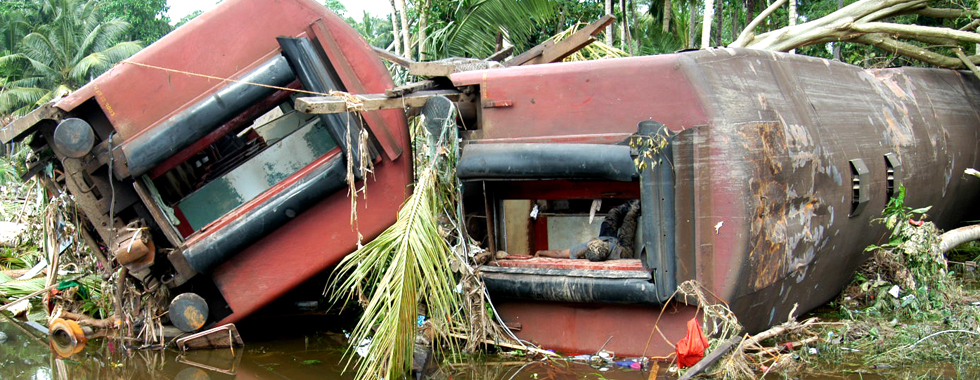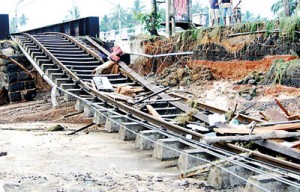Sunday Times 2
Devastated Queen
For the people of Sri Lanka, December 26, 2004, was a double holiday, for apart from being the day after Christmas, a secular occasion enjoyed by the entire population, it was also the full moon day known as Unduwap Poya, observed by the country’s Buddhist majority. From around 6 am, 1,500 people, many of them clustered in families with excited children dressed in their best outfits, flocked to Colombo’s Maradana railway station and filled to capacity a train that they thought would whisk them to “a magic land of white sand and blue seas” — the south coast of the island — to quote Grace Delobel from her short story “Queen of the Sea”. (This work was awarded first place in the short story contest of the Smoking Poet, 2008.)
The title is the translation of the Sinhala name “Samudra Devi” given to this particular service that terminates at Matara, 160 kilometres away. Departure time was 6.40 am, but Sri Lanka’s trains are notorious for their poor time-keeping. Operations that day, though, were atypical in two respects. The first was later revealed to the press by the head guard of the train, Wanigaratne Karunatilake: “Invariably there is a delay of fifteen to thirty minutes, but on December 26, for the first time in my career as a guard, we left Maradana sharp on time.”

Perished in Peraliya: The carriages of the ill-fated train
The other difference was that the Samudra Devi is usually powered by a Canadian M7 locomotive, but that day a speedier M2 was used to pull the eight carriages. Therefore the overcrowded train – probably two hundred ticketless travellers jumped aboard along the way — was ahead of schedule, which was to have a profound consequence on the fate of the train. If it had been running behind schedule as normal, the Samudra Devi would have avoided being inundated by the tsunami.
Another telling factor was that the engine driver had no mobile phone (four other trains, whose drivers did have mobile phones, escaped the waves). Therefore, according to evidence presented at the inquiry, the railway control room had made concerted efforts to contact the nearby stations of Ambalangoda and Hikkaduwa by telephone to warn the driver. The train had actually stopped at Ambalangoda when repeated attempts were made to call the station master, but he was involved in the unloading of goods. By the time he received the message the train had left.
At 9.30, near Peraliya village, ninety-three kilometres from Colombo, the signals were red as the area had already been hit by the first waves, so the driver stopped the train, unaware of the true situation. The train had reached the stretch of track that followed the curve of a wide bay, coming within metres of the beach. Soon water surged around it. Hundreds of villagers, believing the train to be secure, climbed on top to avoid being swept away, while others stood behind it, hoping its weight would take the force of the water.
Water gushed into the carriages up to waist-level. Many passengers stood on their seats. Twenty minutes later the next wave, the tsunami’s biggest, some nine metres high, picked the train up, detached the carriages and hurled them against the trees and houses which lined the track. Those atop the carriages were flung into the treacherous water and those seeking shelter behind them were crushed. The eight carriages were so packed with people that the doors could not be opened, and they filled with water, drowning almost everyone inside. The Queen of the Sea no longer ruled the waves.
Only several dozen survived to give an account of what transpired, one of them being the head guard, Karunatilake: “Suddenly we heard a monstrous sound coming from the sea and a huge blackish-grey wave like that of a makara [dragon] rose high above the coconut trees. Passengers were screaming. I heard ithibiso [pirith, a recitation defined as "protection from all directions"] being chanted by Buddhists and some Muslim boys praying to Allah.”
“This wave took up eighty-five percent of the horizon, and it was coming toward us,” said UK-based Shenth Ravindra, aged twenty-five. “It wasn’t a wave, like a curl with surf, it was just a wall, like a cliff face of water.” He said there was panic as passengers tried to brace themselves and hang on to the children on board. The second wave hit the train as it was at this angle and it pushed his carriage inland until it became wedged against a house. He then jumped from the top of the carriage onto the roof of the house and later decided to swim for it because he was afraid the house would collapse, or that there would be another wave. “There was like a sea of dead bodies, children and women mainly . . . I had to clear a path through the water by pushing them away and heading as far inland as possible.”
After the ultimate wave, twelve-year-old Madushika Kalhari’s father broke the glass pane of a window and crawled out. With the help of her mother, Madushika was lifted through the window, followed by her younger brother Naween. But when her father tried to lift her mother out of the carriage, another passenger held on to her legs in his effort to escape, sealing both their fates.
It’s not known how many people died, but the toll is estimated to be between 1,700 and 2,500, although only 824 bodies were recovered as many were swept out to sea or taken away by relatives without informing the authorities. Thus Peraliya has become the site of the world’s worst train disaster, eclipsing the Bihar disaster of 1981 when 800 died after a cyclone toppled a train into a river. The village itself also suffered heavy losses: hundreds of inhabitants died and out of 420 houses, only ten were spared.
Immediately after the disaster the surviving inhabitants of Peraliya considered the train to be a curse to their village. Yet when the railway authorities removed the carriages during the rebuilding of the line the villagers realised the train was now part of their collective soul. They demanded its return, so a short parallel line was created and three of the carriages were placed on it as a memorial.
The photographic image played a significant and varied role in the story of the Peraliya disaster. Those that portrayed the aftermath — the eight crumpled and battered carriages, some toppled, all scattered in a devastated landscape; the strewn, torn clothing; the piles of detached wheels and bogies; the rail track curled like a Möbius strip – gave the world a glimpse of the horror of the tsunami’s Ground Zero.
The disaster reinforced the perception that photographs are essential memory aids for those whose home environment has been destroyed. In Communicating Disasters: An Asia Pacific Resource Book (2006), edited by Nalaka Gunawardene and Frederick Noronha, Shahidul Alam reports: “I came across a family that had gathered in the wreckage of their home. I wanted to ask them their stories, find out what they had seen, but stopped when I saw them pick up the family album. They sat amidst the rubble and laughed as they turned page after page.”
The voyeuristic impulse of outsiders prevailed, the chance of a ghoulish photo-opportunity grabbed. Amantha Perera reported in the Sunday Leader of April 24, 2005: “Tourists local as well as foreign are trooping to Peraliya like never before, as if it were the star attraction at an amusement park.
“There is the [foreign] woman in a reddish pair of shorts and matching top [about to have her picture taken]. ‘Move closer; make sure you get the carriage, okay?’ She shouts instructions as her eyes pan the props for the best spot to pose. After several shots, she asks aloud, ‘What happened here? How many died?’”
A positive photographic aspect was revealed by Stephen Khan in “Postcards from Peraliya” in The Independent of March 7, 2005. “Before the wave, many Sri Lankan children had hardly seen a camera. So, when the world’s media arrived, many were frightened when cameras were pointed at them.”
Juliet Coombe, one of many international volunteers who travelled to Peraliya to assist the villages, hit upon a plan. Give the children cameras. “It struck me that their perspective of this devastated village and its iconic train would be interesting; but more importantly, I thought photography could serve as a form of therapy, by helping the children to confront their fears.’
“And one image dominates the children’s portfolios – the train. ‘The train has become part of the village. It is etched on their lives.’
“Nine-year-old Danuka gave an insight into the significance of the train. ‘The broken carriages look like my friend’s tsunami scars. The train is bleeding. So many people died. I feel the carriages are like open wounds.’” Today, the carriages are more like open wounds, quickly rusting away. It’s a transient memorial, just like the fading poem from a husband to his lost wife written on the side of a carriage:
Did the children and I come to you when the waves came?
Were the kids there with you when death came?
In eternity, do you want to be mine again?
Will you come back at least in my dreams?
(This article was first published in Himal Southasian (Kathmandu), Vol. 24, No. 3, March 2011)
Never again: Sri Lanka Railways says all systems on trackHow much has been done since the tsunami of 2014 to ensure that a tragedy such as the Peraliya disaster does not happen again?  The twisted track after the tsunami “A lot of things have changed within these past ten years in the communications of Sri Lanka Railways,” says SLR Director (Planning) Vijaya Samarasinghe, explaining that they are now part of a major network which brings together Sri Lanka Railways with several other departments such as the Disaster Management Centre, the Meteorological Department, the Police Department, the Department of Fire and Rescue and even the Bomb Squad. “Any warning sent to us will immediately be forwarded to the three Train Control offices in Colombo, Anuradhapura and Nawalapitiya. These centres will in turn warn the entire workforce of the Sri Lanka Railways including the Engine drivers who are driving the trains at the moment. These communications are done through a secure and fail-safe medium that connects all train stations island-wide through an interconnected network,” he assured. He said that in case of an emergency, even the general public could warn the Sri Lanka Railways by calling the Police emergency hotline 119. – T.M. |

